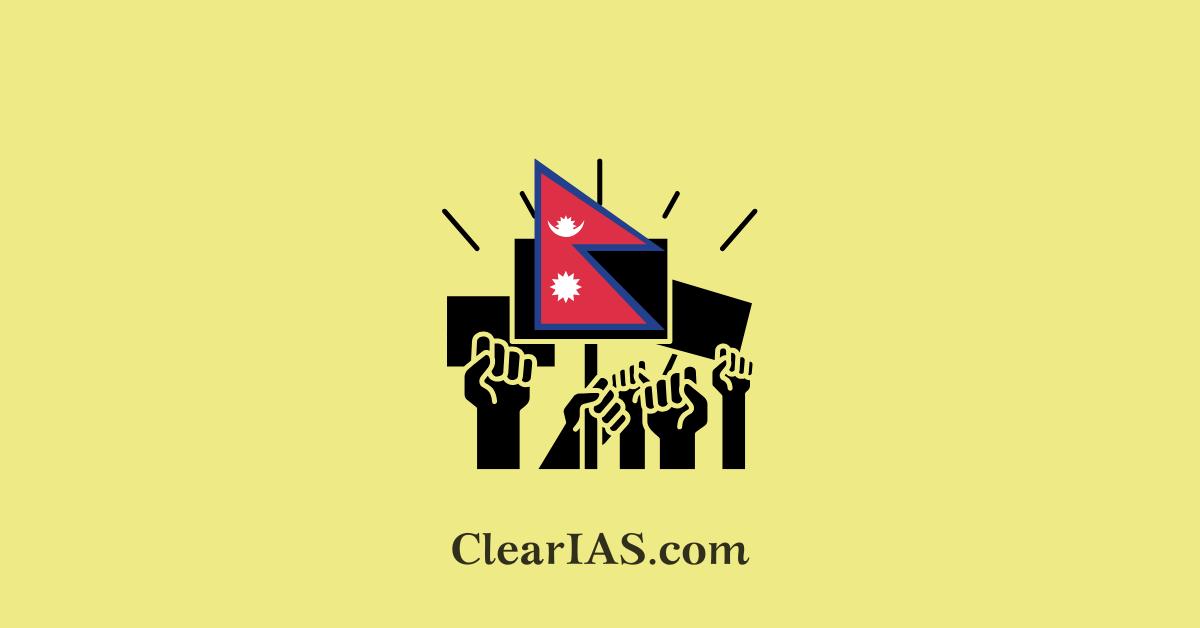
Political Instability in Nepal began as a youth-led protest movement against corruption. With the government’s decision to ban 26 social media platforms, it has spiralled into violent attacks on government buildings and the homes of prominent politicians. Read here to learn about the crisis and India’s stand.
Nepal, known for its scenic Himalayas and rich cultural heritage, is facing a growing wave of youth-led discontent.
The recent “Gen Z protests,” which began as demonstrations against the government’s ban on social media outlets and rampant corruption, have escalated into widespread attacks on public institutions.
These protests are more than spontaneous outbursts; they reflect years of frustration rooted in political instability, economic hardship, and systemic governance failures.
A History of Political Instability in Nepal
Since the restoration of democracy in 1990, Nepal has witnessed 30 changes in government, a striking figure that underlines its chronic political instability.
- Despite significant transitions, from a constitutional monarchy (1990–2008) to a federal democratic republic (post-2008), no Prime Minister has ever completed a full term.
- Frequent government collapses, opportunistic alliances, and factional power struggles have eroded public trust in democratic institutions.
- For young people, this has translated into policy paralysis on key issues, such as education, job creation, and social justice.
Corruption and Governance Deficit
Nepal consistently ranks poorly on corruption indices, with widespread graft, nepotism, and misuse of public funds undermining development efforts.
The extravagant lifestyles and privileges of politicians and their families stand in sharp contrast to the economic struggles of ordinary citizens.
High unemployment, limited opportunities, and rampant corruption have created a climate of resentment. For young people forced to migrate for jobs abroad, this sense of exclusion and betrayal is particularly acute.
- Youth movements have long demanded better governance and accountability, but successive governments have failed to deliver tangible reforms.
- The recent social media ban was perceived as an attempt to curb dissent rather than address root problems, sparking outrage among Nepal’s digitally connected Generation Z.
Economic Difficulties and Remittance Dependence
Economically, Nepal is one of the world’s most remittance-dependent countries, ranking fourth globally.
Roughly a quarter of Nepal’s GDP is derived from remittances sent home by migrant workers, many of whom are young men and women seeking employment in the Gulf, Malaysia, and India due to limited opportunities at home.
- While remittances provide a financial lifeline, they also reflect a failure of domestic job creation.
- Youth unemployment and underemployment remain persistently high, leaving a whole generation feeling excluded from the benefits of economic growth.
- The lack of industrialisation and over-dependence on agriculture and tourism further limit prospects for upward mobility.
Gen Z: The Face of a Frustrated Generation
Generation Z in Nepal, those born roughly between the mid-1990s and early 2010s, are better educated, more tech-savvy, and more globally aware than previous generations.
- However, they are also more disillusioned. They experience the sharp contrast between the democratic ideals promised to them and the ground reality of corruption, unemployment, and political stagnation.
- Social media has given them a platform to mobilise, amplify their voices, and coordinate protests rapidly.
- The ban on these platforms became the immediate trigger for protests, but the underlying rage stems from decades of unaddressed structural inequalities.
Rather than engaging with protesters, authorities responded with heavy-handed tactics, including firing on crowds, which led to civilian casualties.
The crackdown further inflamed public anger and turned peaceful demonstrations into violent confrontations, with government buildings and politicians’ residences targeted by enraged mobs.
Societal Inequalities and Regional Disparities
Nepal’s development has been uneven, with significant gaps between urban and rural regions, as well as between dominant and marginalized communities.
Persistent inequalities in access to education, healthcare, and economic resources have deepened frustrations, particularly among youth from disadvantaged backgrounds.
Consequences of Rising Youth Discontent
Unchecked anger among Nepal’s youth risks destabilising the country further.
Prolonged protests can disrupt economic activity, deter tourism (a vital sector), and create security challenges.
More importantly, it threatens to deepen the divide between the government and the governed, further weakening faith in Nepal’s democratic system.
India’s Troubled Neighbourhood and Its Impact
The crisis in Nepal is not an isolated development but part of a broader pattern of political fragility across South Asia.
Sri Lanka’s economic collapse, Bangladesh’s political turmoil, and now Nepal’s unrest collectively highlight the volatility in India’s immediate neighbourhood.
Spillover Risks for India:
- Trade and Market Disruption: Nepal is a key trading partner and transit route for India. Prolonged instability could disrupt supply chains and markets.
- Migration and Refugee Concerns: Political crises often lead to refugee inflows, posing humanitarian and border management challenges for India.
- Security Implications: Instability near India’s borders can create space for extremist groups and transnational criminal networks, complicating India’s security calculus.
- Diplomatic Challenges: A prolonged crisis in Nepal strains India’s cultural and economic ties and risks pushing Nepal closer to other regional powers seeking influence.
India’s Response:
Recognizing the gravity of the situation, the Prime Minister of India convened a meeting of the Cabinet Committee on Security (CCS) and emphasized that “the stability, peace, and prosperity of Nepal are of utmost importance for India.” India’s approach is likely to focus on:
- Diplomatic engagement with Nepalese political actors to encourage dialogue and consensus-building.
- Supporting Nepal’s democratic processes while avoiding interference in internal politics.
- Enhancing humanitarian assistance and development cooperation to stabilize Nepal’s economy.
Way Forward
To address the concerns of its youth and avoid a cycle of unrest, Nepal must undertake:
- Political Reforms: Ensure stable governance by discouraging opportunistic alliances and fostering coalition discipline, so governments can complete their terms and deliver on promises.
- Job Creation & Economic Diversification: Invest in infrastructure, manufacturing, and skill development to create employment opportunities at home and reduce over-dependence on remittances.
- Transparency & Anti-Corruption Measures: Strengthen institutions like the Commission for Investigation of Abuse of Authority (CIAA), enhance whistle-blower protection, and digitize public services to reduce corruption.
- Inclusive Policies: Bridge urban-rural divides and uplift marginalized communities to build social cohesion.
- Constructive Youth Engagement: Involve young people in policy dialogue, civic education, and entrepreneurship programs to channel their energy into nation-building.
Conclusion
The Gen Z protests in Nepal are a wake-up call, signalling that mere changes in political leadership are not enough; systemic reforms are essential.
A generation that has grown up amid endless government collapses and limited opportunities is demanding dignity, stability, and a future worth staying for.
Addressing their grievances will require sustained political will, economic innovation, and inclusive governance to prevent Nepal’s democracy from spiralling into deeper instability.
For India, Nepal’s stability is not just a matter of neighbourhood diplomacy but a strategic imperative for regional peace and economic integration. The coming months will be crucial in determining whether Nepal can emerge from this crisis with stronger democratic foundations or descend into prolonged political instability.
Related articles:







Leave a Reply